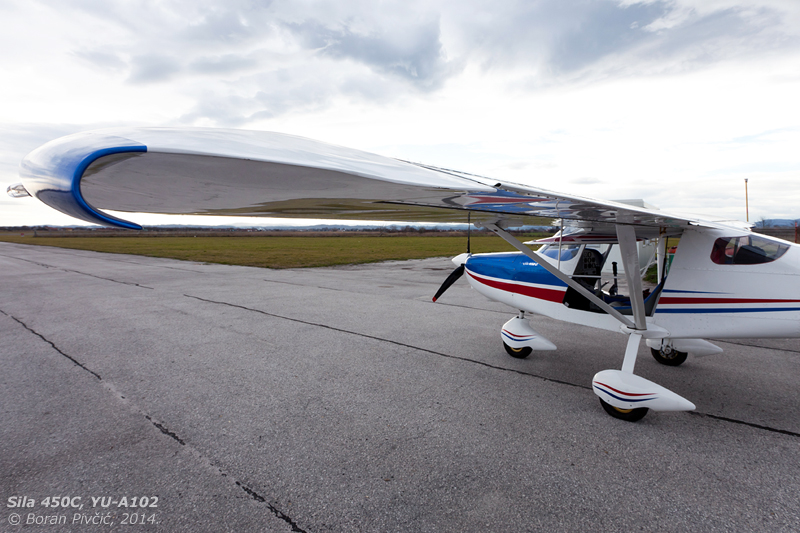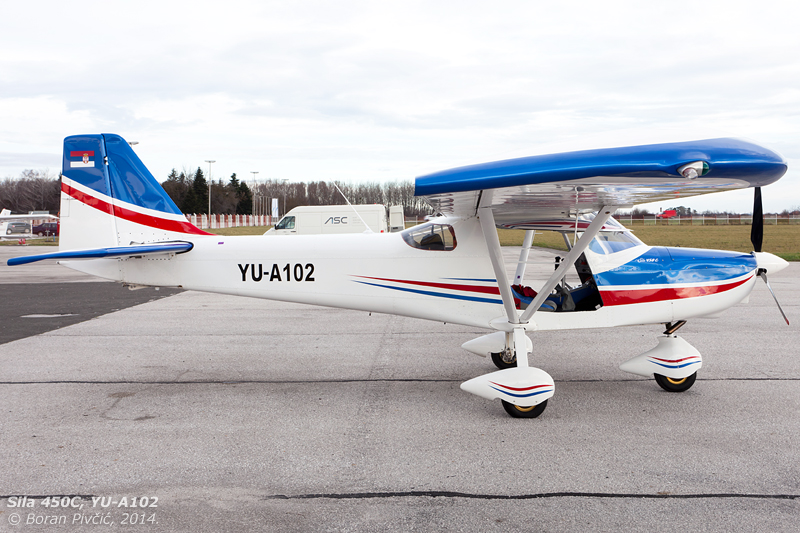By me
All photos me too, copyrighted
Back in 2012 while on a short visit to Belgrade, Serbia, a friend and I had decided – in true Achtung, Skyhawk! tradition 😀 – that we might as well do some proper sightseeing and head out to the old UTVA aircraft factory in Pančevo, a couple dozen kilometers up the main road. Once the powerhouse of Yugoslavia’s aircraft industry, this enormous factory was, among other things, responsible for the most ubiquitous light aircraft in the country’s history – the much maligned UTVA-75 – a machine that, despite all its faults, had quickly come to dominate aprons across the land (and the occasional newspaper accident column 🙂 ). Singularly robust machines – the DC-9s of the light single world – many 75s continue to soldier on even today, with a select few also having seen combat action as impromptu light attack aircraft during the turbulent 90s.
By 2012 however, the factory’s shine had long gone and its successes largely forgotten. A dilapidated ruin that had been heavily damaged during the 1999 NATO air strikes, the factory exists today as a rump facility at best, fiddling with a handful of low-scale projects on a thin shoestring budget. While a sad sight in its own right, the view that had greeted us had also represented a striking metaphor for former Yugoslavia’s aviation industry as a whole – and not least of all for the flat spin it had taken during the country’s violent disintegration. Largely scattered across the land, it would – unsurprisingly – take a crippling hit at the start of the 90s war, losing its supplier and customer bases virtually overnight. The widespread financial disasters that had succeeded the conflict never really gave the industry the breathing space it needed to recover, turning the whole aviation landscape into an archaeologist’s playground of abandoned factories, forgotten companies and rotting gate guards.
May the Force be With You
But, in what is a long-overdue resurrection of the region’s large(r) scale light aircraft industry, one manufacturer had nevertheless managed to part the red tape and defy the economic odds, adding its bit to putting the industry back on the proverbial map 🙂 . The company in question is Aero East Europe, a small but efficient unit operating out of a historic workshop in the southern town of Kraljevo, and nowadays well on its way to building up a respectable regional reputation for its original STOL ultralight designs. Fighting its way up the sales ladder against various copies and modifications of the legendary Zenair CH-701, the flagship of the fleet is the 450 kg / 992 lbs SILA 450, an example of which had popped into Varaždin Airfield (LDVA) on 18 January for a brief promotional visit. No prizes for guessing whether I was there… 😀

Apart from a name that tends to raise eyebrows among Southern Slavic language speakers – literally meaning “force”, but in reality just short for Serbian Industry of Light Aircraft – the 450 appears largely unremarkable at first glance, sharing much of the visual cues of other high wing STOL ultralights. Its specs too (at least on paper) are not enough to set your blood racing; compared to the ICP Savannah XL, the 450’s latest iteration – the 450C – can carry five kg / 11 lbs less, cruises just 6 knots faster, and needs five meters / 16 ft less to take-off and 10 meters / 32 feet more to come to a full stop.
Up front there’s a 100 HP Rotax 912ULS whirling a three-blade ground-adjustable prop – hardly an exciting feature – while equipment-wise you’re looking at electrically actuated flaps, a ballistic parachute recovery system and an optional glass cockpit… essentially the same kit you can get from any other manufacturer out there.
However, once up close and past the preliminaries, a startling number of interesting – and unusual – details begin to emerge 🙂 . The wing, for example, is a mechanically simple affair that makes do without the slats, slotted controls and vortex generators seen on the CH-701 and its spin-offs. Instead, the 450 uses a plain but very thick airfoil profile that simplifies the wing’s internal structure, while at the same time preserving low speed handling and performance and noticeably reducing drag (which will always be high on a STOL wing). Indeed, the 450 can boast a lift-to-drag* ratio od 1/15, quite a bit up from the 1/11 of the Savannah XL (a number also shared with, of all things, the Cessna Skyhawk 🙂 ).
* a common measure of the aircraft’s aerodynamic efficiency, the lift-to-drag ratio – often abbreviated to L/D and sometimes also called the “finesse” – in effect shows how much horizontal distance would the aircraft, unpowered and gliding, be able to cover for each unit of vertical distance lost. The SILA’s 1/15 for example denotes that for every foot of altitude lost, it would be able to glide 15 feet in still air. Scaled up a bit, this means that for a 1,000 ft altitude decrease, it would cover 15,000 ft horizontally (roughly 4.5 km / 2.5 NM). Apart from quantifying the aircraft’s overall aerodynamic prowess, this number also comes in handy during flight planning, allowing you to pick out – in advance – suitable landing fields along your route for the event that your engine decides it has grown tired of working 🙂 .

To compensate for the lack of slats and slotted controls at the lower end of the speed range, the 450 is fitted with drooping ailerons, which lower slightly as the flaps pass their halfway travel mark. Combined with the chunky airfoil, they give the aircraft an almost comically low minimum flying speed in the low 30-ish of knots – which was demonstrated to me graphically against the day’s stiff 30 knot headwind at altitude 😀 .
The combination had also acquitted itself well handling-wise, with the 450 displaying unexpectedly impressive flight characteristics in all regimes, high or low, slow or fast. Perhaps its biggest surprise – to a Cessna driver 🙂 – was not what it could do, but the way it did it, with an almost complete lack of aerodynamic drama, pussycat stall and post-stall response, and virtually no buffeting or waywardness anywhere in the standard part of the envelope*.
* in fairness though, I’ve not had much ultralight experience, so I can’t really make an objective handling comparison with other designs… but I can however draw parallels with the similarly sized (though heavier) Cessna 150, which the 450 – in a number of comparable respects – blows clear out of the water 🙂 .
Cabin Space – The Final Frontier
But, even before one gets a grip on the stick, he/she can notice a raft of other nice touches scattered all over the airframe. One that I – standing 1.93 m / 6 ft 3 in tall – can particularly appreciate is the wide and roomy cabin, almost an order of magnitude more spacious and comfortable than that of the 150. Entry and egress is unexpectedly easy from both sides, courtesy of an upward hinged door and wing struts positioned behind the doors, at the joints of the main gear legs.



There’s other evidence of the design having been thoroughly thought out. The ailerons and elevators, for example, are actuated by pushrods rather than conventional cables (which are retained for the rudder only), giving a quicker control response and eliminating a number of maintenance issues (delaminating cables being one of them). The space behind the panel is remarkably clean as well, with plenty of legroom and none of the wiring, piping and mechanical whatnot frequently found on Cessnas and Pipers. And – what had caught my attention right from the start 🙂 – there’s a small double L mount hanging from the ceiling just aft of the windshield, allowing you to securely deposit your headphones when not in use*.
* while this is not much of an issue in the grand scheme of things – and certainly not the reason to choose the SILA over any other design – loose headphones can become quite a nuisance. In light Cessnas for example, you either have to hang them from the yoke (not the most practical solution in a small cockpit), leave them on the seat, or, worst of all, put them on top of the panel where they’re exposed to sunlight – and where their speaker magnets can play havoc with the magnetism of the compass.
These practical details continue on the outside as well. The fuel tank caps open, close and latch only with the master switch key, avoiding unintentional flight with the tanks unsecured (and, since we’re on the Balkans after all, also avoiding intentional fuel theft 😀 ). Up front, large access panels are provided on the cowl, allowing for quick inspections and repair without the need to dismantle the whole nose. And – unusually for an aircraft that has a small, light prop and barely treble digits of power – YU-A102 also came equipped with a rudder trim system, operated electrically (like its elevator equivalent) by push buttons located on the tops of both sticks.

Certifiably good?
But, while everything said so far sounds very enticing, one other important item still remains – the naughty business of price 🙂 . What you’d eventually pay for one of these naturally depends on what equipment options you’d go for, but the base model – broadly identical to YU-A102 – would set you back about EUR 62,000. Around 30,000 more would get you the top-of-the-line version, equipped with digital avionics (a Dynon Skyview/Garmin G3x mix) and full interior night lighting.
From what I’ve seen while scouting through the European classifieds and various vendor sites, this is a fair bit (EUR 10,000+ to be exact) more expensive than the performance and engine-wise very similar Savannah XL. While at face value this does seem to be a mystery, the SILA’s higher purchase costs can be attributed to its certification ambitions, having been designed to be fully compliant with the JAR VLA Part 21 standard – while already holding Germany’s own equivalent, the LTF-UL certificate.
But, will this paper be enough to overcome the higher price – and will the aircraft’s features manage to overcome the lingering stigma of its country of origin – still remains to be seen…

Specifications:

Manufacturer links:
- Aero East Europe – main page
- Aero East Europe – SILA 450C
- Aero East Europe – SILA 450C specifications (PDF)
Other links & sources:
- ICP Aviazione – Savannah XL specs
- various aviation classifieds
One thought on “Photo Report – The Force 450 Gale: Serbia’s SILA 450 UL”